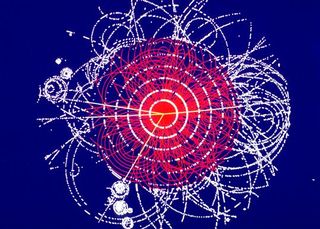Probable Higgs Boson Particle Just Plain 'Vanilla'

The new subatomic particle discovered this summer is very likely the Higgs boson scientists hoped it was, and probably the most standard, "vanilla" kind, scientists say.
Two experiments at the Large Hadron Collider, a17-mile (27 kilometer) underground loop beneath Switzerland and France, reported in July that they'd found a new particle that weighed about 125 times the mass of the proton.
Now, those experiments, called ATLAS and CMS, have reported their latest data, which include many more measurements than were available four months ago, during the Hadron Collider Physics Symposium in Kyoto, Japan.
The newest findings indicate that not only is the particle probably the Higgs boson, but it is the basic version of the particle predicted by the dominant theory of particle physics, called the Standard Model. The Higgs is thought to be the particle responsible for bestowing mass on all other particles. [What Is the Higgs Boson? ('God Particle' Explained)]
"The particle behaves in rather disappointingly good agreement with what the vanilla Standard Model expects," physicist Tommaso Dorigo, a member of the CMS collaboration, wrote on his blog.
The note of regret expressed by some physicists at the news reflects the hope that the Higgs would prove different from the standard prediction, thus opening the door for some of the more exotic physics theories that many scientists suspect are necessary to truly describe the universe.
For example, some physicists hope for support for a theory called supersymmetry, which predicts the existence of hidden partner particles for all the known particles. However, no evidence for these "superpartner" particles has yet been found.
Sign up for the Live Science daily newsletter now
Get the world’s most fascinating discoveries delivered straight to your inbox.
"It is still too early to tell, but the new boson looks like, sings like and dances more and more like a Higgs boson," Pauline Gagnon, an Indiana University physicist working on the ATLAS experiment, wrote on the official CERN blog Quantum Diaries.
"More certainty will come out next March at a winter conference with still more data and improved analyses," Gagnon added. "But it will take a long time to figure out beyond any doubt if the discovered boson was really the Standard Model Higgs boson.
Still, the physicists have made much progress toward understanding the newfound particle. Although the particle itself is unstable and doesn't last long, typically decaying into other particles almost immediately, the physicists can study the signatures of the particles it turns into.
The scientists have confirmed with more certainty that the Higgs-like particle has a mass between 125 to 126 times the mass of the proton, a unit called a gigaelectron volt (GeV). And they've tested its other properties, such as spin and parity (a characteristic roughly akin to being left- or right-handed). So far, these all align with the predictions of the Standard Model.
"With more than twice as much data as shown in July, scientists have moved from searching for this elusive particle to starting to measure its properties," Gagnon said. "Once the decay channels, decay rates, spin and parity are clearly established, we will be able to determine its identity."
If it is the Higgs, the discovery will help explain why particles have mass at all. The theory goes that the Higgs boson is associated with a Higgs field that pervades space. As other particles travel through this field, they gain mass based on how strongly they interact with it.
The idea was first suggested in the 1960s, but relies on a definitive discovery of the Higgs boson to prove it true.
Follow Clara Moskowitz on Twitter @ClaraMoskowitz or LiveScience @livescience. We're also on Facebook & Google+.
Most Popular

